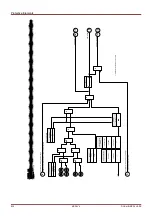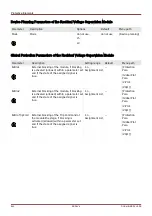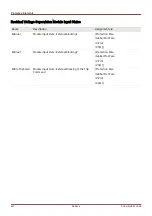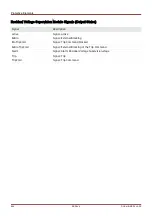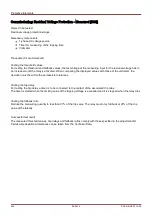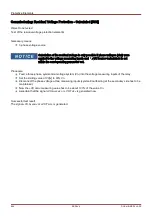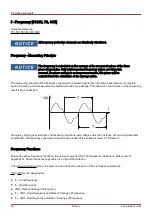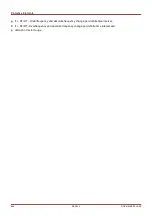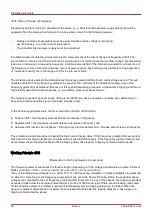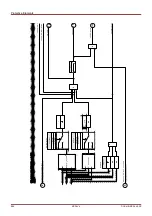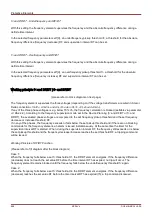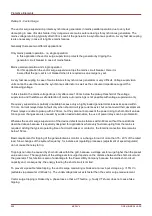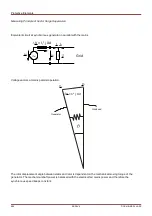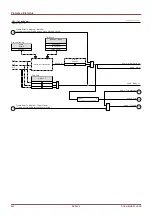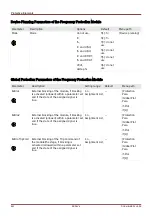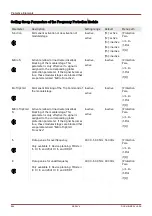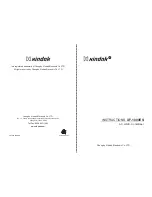
Protective Elements
df/dt - Rate of Change of Frequency
Electrical generators running in parallel with the mains, (e. g. industrial internal power supply plants), should be
separated from the mains when failure in the intra-system occurs for the following reasons:
•
Damage to electrical generators must be prevented when mains voltage is recovering
asynchronously, (e. g. after a short interruption).
•
The industrial internal power supply must be maintained.
A reliable criterion of detecting mains failure is the measurement of the rate of change of frequency (df/dt). The
precondition for this is a load flow via the mains coupling point. At mains failure the load flow change spontaneously
leads to an increasing or decreasing frequency. At active power deficit of the internal power station, a linear drop of
the frequency occurs and a linear increase occurs at power excess. Typical frequency gradients during application
of "mains decoupling" are in the range of 0.5 Hz/s up to over 2 Hz/s.
The protective device detects the instantaneous frequency gradient (df/dt) of each mains voltage period. Through
multiple evaluations of the frequency gradient in sequence the continuity of the directional change (sign of the
frequency gradient) is determined. Because of this special measuring procedure a high safety in tripping and thus a
high stability against transient processes, (e. g. switching procedure) are achieved.
The frequency gradient (rate of change of frequency [df/dt]) may have a negative or positive sign, depending on
frequency increase (positive sign) or decrease (negative sign).
In the frequency parameter sets, the User can define the kind of df/dt mode:
Positive df/dt = the frequency element detects an increase in frequency
Negative df/dt = the frequency element detects a decrease in frequency and
Absolute df/dt (positive and negative) = the frequency element detects both, increase and decrease in frequency
This protection element provides a tripping threshold and a tripping delay. If the frequency gradient df/dt exceeds or
falls below the set tripping threshold, an alarm will be issued instantaneously. If the frequency gradient remains still
above/below the set tripping threshold until the tripping delay has elapsed, a tripping command will be issued.
Working Principle df/dt
(Please refer to the block diagram on next page)
The frequency element supervises the three voltages (depending on if the voltage transformers are wired in Star or
Delta connection »
VL12«, »VL23« und »VL31« oder »VL1«, »VL2« und »VL3«).
If any of the three phase voltages is e.g. below 15% Vn, the frequency calculation is blocked (settable via parameter
»
V Block f«). According to the frequency supervision mode set in the Device Planning (df/dt), the evaluated phase
voltages are compared to the set frequency gradient (df/dt) threshold.
If in any of the phases, the frequency gradient
exceeds or falls below the set pickup threshold (acc. to the set df/dt mode) and if there are no blocking commands
for the frequency element, an alarm is issued instantaneously and the tripping delay timer is started. When the
frequency gradient still exceeds or is below the set pickup threshold after the tripping delay timer has elapsed, a
tripping command will be issued.
851
MCDLV4
DOK-HB-MCDLV4-2E
Summary of Contents for HighPROtec MCDLV4
Page 3: ...Order Code Order Code 3 MCDLV4 DOK HB MCDLV4 2E...
Page 47: ...Installation and Connection 47 MCDLV4 DOK HB MCDLV4 2E...
Page 164: ...Input Output and LED Settings 164 MCDLV4 DOK HB MCDLV4 2E...
Page 433: ...Parameters 433 MCDLV4 DOK HB MCDLV4 2E...
Page 457: ...Device Parameters 457 MCDLV4 DOK HB MCDLV4 2E...
Page 473: ...Blockings 473 MCDLV4 DOK HB MCDLV4 2E...
Page 988: ...Protective Elements 988 MCDLV4 DOK HB MCDLV4 2E P P Q P Q P Q Q Q P S S...
Page 989: ...Protective Elements 989 MCDLV4 DOK HB MCDLV4 2E Pr Q P Q P Qr...
Page 1023: ...Protective Elements 1023 MCDLV4 DOK HB MCDLV4 2E...



